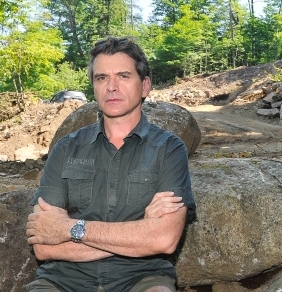Unpublished Opinions
A writer, certified/literary translator and communications specialist with nearly 25 years experience working on Parliament Hill. In 2015, Ekstasis Editions published his translation of Robert Lalonde's Little Eagle With a White Head, winner of the 1994 Governor General's Award for French Fiction, and the 1995 France-Québec Prize. He is the former managing editor and English translation coordinator for the magazine Cité libre, founded by Pierre Elliott Trudeau in 1950. From April to November 2015, he was French language translator for the Office of the Leader of the Liberal Party of Canada. In 2017, Ekstasis released his translation of Robert Lalonde's The World on the Side of a Trout, "a meteorological journal of the mind, a meditation on the art of seeing, reading and writing by one of Quebec’s finest novelists." His translations of Robert Lalonde's The Little Thief, and André Major's The Devil's Wind were published in 2019 by Ekstasis. His translation of the same author's Iotékha' came out in early 2020. The Club, his translation of a short story by Louis Hamelin was included in Granta Magazine's special 2017 issue on Canadian literature. Email: jp.murray@live.com
Sellout or Step Forward? NCC to Approve Latest Gatineau Park Plan Jan. 21
The National Capital Commission's 2020 Draft Gatineau Park Master Plan was strongly criticized as a sellout to private interests. On Thursday, January 21, 2021, we'll see whether the NCC confirms the sellout, or moves forward with its long-standing vision of a public park managed with a strong ecological mandate.
Capitulating to private interests, and violating the park’s public and ecological missions, the 2020 Draft Gatineau Park Master Plan is a confused hodgepodge of half-baked ideas, and a resounding failure.
From saying in all its previous master plans that private properties harm the environment and are inconsistent with the park’s mission, the NCC now sees park residents as partners, stewards and protectors of the land.
“Stewardship of the park will continue to be a shared responsibility through the collaboration and active participation of residents,” says the draft plan on page 21. “Private landowners and commercial tenants will contribute to the collective effort to protect the park.”
The draft plan’s authors seem to have forgotten that in their “collective efforts to protect the park,” residents have built 11 new houses at Meech Lake since 2006 (not to mention their constant efforts to limit public access). Moreover, the Canadian Parks and Wilderness Society recently denounced construction of nearly 140 houses in the park over the last 30 years.[1]
What is perhaps most shocking, is how disjointed and confused the NCC’s new approach to private lands is: on the one hand, it claims that the park will be managed as an IUCN Category II national park[2] (pages 13, 27 and 44), which stipulates that human occupation must be prevented and eliminated... On the other hand, it portrays residents as park protectors (p. 21), while encouraging them to develop their properties in an ecologically responsible manner (p. 62).
“We had to destroy the park to protect it,” seems to be the draft plan’s philosophy...
IUCN Category II clearly says that human occupation is harmful to protected areas and that it must be prevented and eliminated. A Category II national park is “an area managed mainly for ecosystem conservation and recreation” ... and designated to protect the ecological integrity of ecosystems for this and future generations, by eliminating and preventing “occupation inimical to the purposes of its designation.”[3]
Moreover, IUCN Category II calls for ecosystems to be “not materially altered by human exploitation and occupation,” while expecting governments “to prevent or eliminate as soon as possible exploitation or occupation in the whole area (IUCN, 1990).”[4]
In short, the NCC is sucking and blowing at the same time, by saying that residents are stewards and protectors, but that the park will nonetheless be managed as an IUCN Category II area.
Unless reference to park residents as partners, protectors and stewards is removed, and proper focus is put on the need to continue acquiring private lands and impose a permanent building freeze, the 2020 Gatineau Park Master Plan will go down in history as the milestone that signalled the complete collapse of a conservation park worthy of the name.
(Although the 2020 draft plan is sound in several respects, these positive elements don’t compensate for this sell-out to private interests. The plan's positive elements include the following: 1) urging the government to adopt protective legislation for the park; 2) recognizing R.P. Sparks’ key role in creating the park; 3) specifying, adjusting and clarifying the park’s boundaries; 4) creating wildlife corridors on the park’s periphery; 5) admitting the NCC had misled the public regarding ownership of 61.5 km2 of land in the lac La Pêche sector; 6) getting better visitorship figures; 7) cancelling the Meech Creek Valley Land Use Concept).
The Gatineau Park Protection Committee's full brief is attached to this article.
[1] « Une loi pour protéger le parc de la Gatineau, » Le Droit, 21 août 2020.
[2] Category II Protected Area as defined by the International Union for Conservation of Nature (IUCN).
[3] “Summary and objectives of IUCN Protected Area Management Categories,” in Guidelines for protected area management categories. Commission on National Parks and Protected Areas with the assistance of the World Conservation Monitoring Centre. IUCN, Gland, Switzerland, 1994.
[4] Quoted in Jeffrey A. McNeely and Gayl Ness, “Categories of Protected Areas: A Tool for Building a Better Relationship With Local Communities,” in People, Parks and Biodiversity: Issues in Population-Environment Dynamics, the World Conservation Union: http://www.aaas.org/international/ehn/biod/ness1.htm.



Comments
Be the first to comment